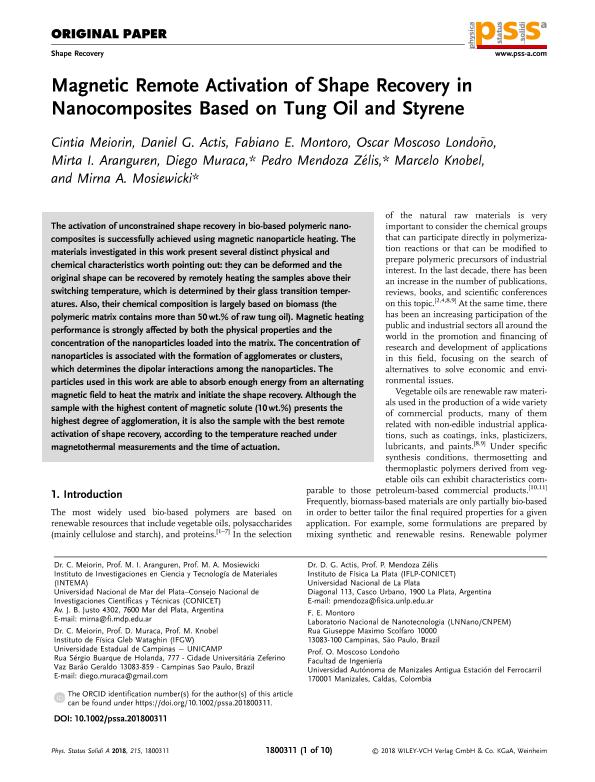Mostrar el registro sencillo del ítem
dc.contributor.author
Meiorin, Cintia

dc.contributor.author
Actis, Daniel Guillermo

dc.contributor.author
Montoro, Fabiano E.
dc.contributor.author
Moscoso Londoño, Oscar

dc.contributor.author
Aranguren, Mirta Ines

dc.contributor.author
Muraca, Diego

dc.contributor.author
Mendoza Zélis, Pedro

dc.contributor.author
Knobel, Marcelo

dc.contributor.author
Mosiewicki, Mirna Alejandra

dc.date.available
2019-08-23T22:30:14Z
dc.date.issued
2018-12
dc.identifier.citation
Meiorin, Cintia; Actis, Daniel Guillermo; Montoro, Fabiano E.; Moscoso Londoño, Oscar; Aranguren, Mirta Ines; et al.; Magnetic Remote Activation of Shape Recovery in Nanocomposites Based on Tung Oil and Styrene; Wiley VCH Verlag; Physica Status Solidi A-applications And Materials Science; 215; 24; 12-2018
dc.identifier.issn
1862-6300
dc.identifier.uri
http://hdl.handle.net/11336/82075
dc.description.abstract
The activation of unconstrained shape recovery in bio-based polymeric nanocomposites is successfully achieved using magnetic nanoparticle heating. The materials investigated in this work present several distinct physical and chemical characteristics worth pointing out: they can be deformed and the original shape can be recovered by remotely heating the samples above their switching temperature, which is determined by their glass transition temperatures. Also, their chemical composition is largely based on biomass (the polymeric matrix contains more than 50 wt.% of raw tung oil). Magnetic heating performance is strongly affected by both the physical properties and the concentration of the nanoparticles loaded into the matrix. The concentration of nanoparticles is associated with the formation of agglomerates or clusters, which determines the dipolar interactions among the nanoparticles. The particles used in this work are able to absorb enough energy from an alternating magnetic field to heat the matrix and initiate the shape recovery. Although the sample with the highest content of magnetic solute (10 wt.%) presents the highest degree of agglomeration, it is also the sample with the best remote activation of shape recovery, according to the temperature reached under magnetothermal measurements and the time of actuation.
dc.format
application/pdf
dc.language.iso
eng
dc.publisher
Wiley VCH Verlag

dc.rights
info:eu-repo/semantics/openAccess
dc.rights.uri
https://creativecommons.org/licenses/by-nc-sa/2.5/ar/
dc.subject
Functional Nanocomposites
dc.subject
Magnetic Nanoparticle Heating
dc.subject
Magnetic Properties
dc.subject
Remote Activation of Shape Recovery
dc.subject
Vegetable Oil Based Polymers
dc.subject.classification
Nano-materiales

dc.subject.classification
Nanotecnología

dc.subject.classification
INGENIERÍAS Y TECNOLOGÍAS

dc.title
Magnetic Remote Activation of Shape Recovery in Nanocomposites Based on Tung Oil and Styrene
dc.type
info:eu-repo/semantics/article
dc.type
info:ar-repo/semantics/artículo
dc.type
info:eu-repo/semantics/publishedVersion
dc.date.updated
2019-08-01T21:51:37Z
dc.journal.volume
215
dc.journal.number
24
dc.journal.pais
Alemania

dc.journal.ciudad
Weinheim
dc.description.fil
Fil: Meiorin, Cintia. Consejo Nacional de Investigaciones Científicas y Técnicas. Centro Científico Tecnológico Conicet - Mar del Plata. Instituto de Investigaciones en Ciencia y Tecnología de Materiales. Universidad Nacional de Mar del Plata. Facultad de Ingeniería. Instituto de Investigaciones en Ciencia y Tecnología de Materiales; Argentina
dc.description.fil
Fil: Actis, Daniel Guillermo. Consejo Nacional de Investigaciones Científicas y Técnicas. Centro Científico Tecnológico Conicet - La Plata. Instituto de Física La Plata. Universidad Nacional de La Plata. Facultad de Ciencias Exactas. Instituto de Física La Plata; Argentina
dc.description.fil
Fil: Montoro, Fabiano E.. Laboratorio Nacional de Nanotecnologia; Brasil
dc.description.fil
Fil: Moscoso Londoño, Oscar. Universidad Autónoma de Manizales; Colombia
dc.description.fil
Fil: Aranguren, Mirta Ines. Consejo Nacional de Investigaciones Científicas y Técnicas. Centro Científico Tecnológico Conicet - Mar del Plata. Instituto de Investigaciones en Ciencia y Tecnología de Materiales. Universidad Nacional de Mar del Plata. Facultad de Ingeniería. Instituto de Investigaciones en Ciencia y Tecnología de Materiales; Argentina
dc.description.fil
Fil: Muraca, Diego. Universidade Estadual de Campinas; Brasil. Consejo Nacional de Investigaciones Científicas y Técnicas; Argentina
dc.description.fil
Fil: Mendoza Zélis, Pedro. Consejo Nacional de Investigaciones Científicas y Técnicas. Centro Científico Tecnológico Conicet - La Plata. Instituto de Física La Plata. Universidad Nacional de La Plata. Facultad de Ciencias Exactas. Instituto de Física La Plata; Argentina
dc.description.fil
Fil: Knobel, Marcelo. Instituto de Física la Plata (conicet- Universidad Nacional de la Plata); Argentina
dc.description.fil
Fil: Mosiewicki, Mirna Alejandra. Consejo Nacional de Investigaciones Científicas y Técnicas. Centro Científico Tecnológico Conicet - Mar del Plata. Instituto de Investigaciones en Ciencia y Tecnología de Materiales. Universidad Nacional de Mar del Plata. Facultad de Ingeniería. Instituto de Investigaciones en Ciencia y Tecnología de Materiales; Argentina
dc.journal.title
Physica Status Solidi A-applications And Materials Science

dc.relation.alternativeid
info:eu-repo/semantics/altIdentifier/url/https://onlinelibrary.wiley.com/doi/abs/10.1002/pssa.201800311
dc.relation.alternativeid
info:eu-repo/semantics/altIdentifier/doi/http://dx.doi.org/10.1002/pssa.201800311
Archivos asociados
